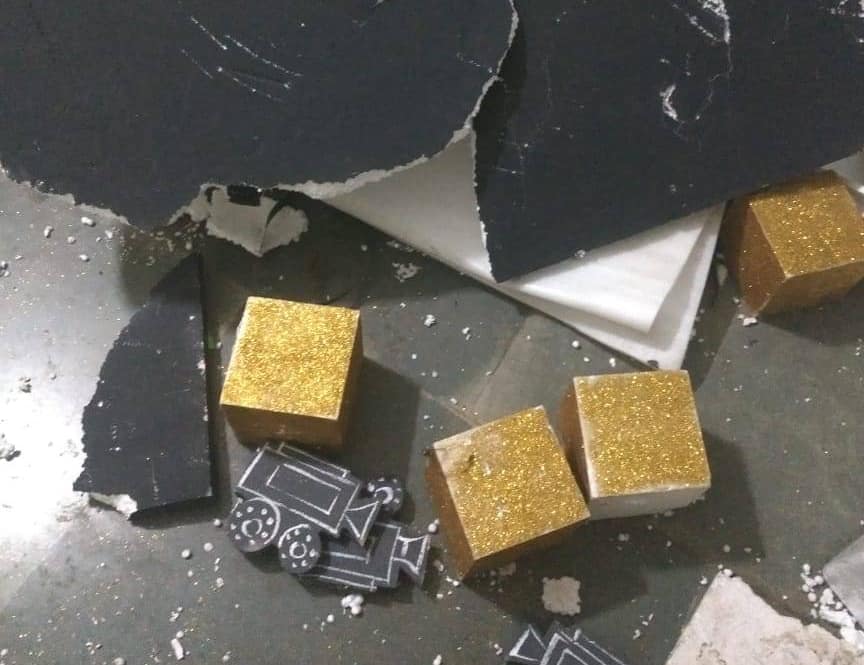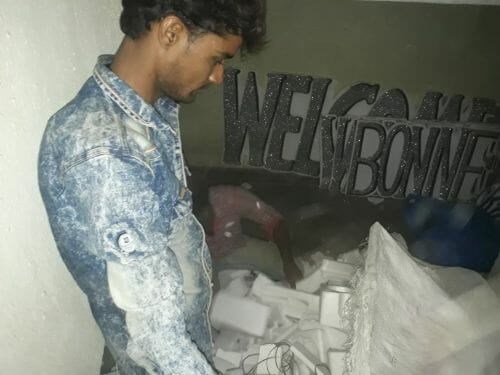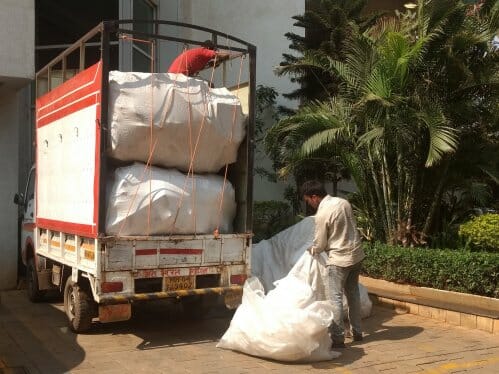Our new refrigerator is arriving, and with it we can be sure of something else – Thermocol as voluminous as the fridge itself. Not so long ago, lunch at the food court meant eating off a Styrofoam plate. What really is Thermocol and Styrofoam?
What is Thermocol and Styrofoam?
Thermocol and Styrofoam are brand names – the former by BASF and the latter by Dow Chemicals.
Thermocol is an EPS (Expanded Polystyrene) and Styrofoam is an XPS (Extruded Polystyrene). Both these polystyrene products are derived from petroleum, just like plastic. Thermocol is so popular that any EPS/XPS is generically called ‘Thermocol’, in the same way that photocopies are called ‘Xerox’.

Polystyrene is a polymer that can be expanded with air (into small white balls that are then further processed to get EPS) or extruded (into the desired shape to get XPS). The manufacturing processes differ and the materials that are created also differ in properties. For waste management purposes we can club them together. We will mostly use the word “Thermocol” for convenience.
Read more: Why shunning thermocol needs to be an essential mandate of every plastic ban
What are the uses of Thermocol?
Thermocol is strong, lightweight and waterproof, which is why it is used extensively in the packaging of electrical goods and furniture. Once we have given our new belongings pride of place in our homes, we promptly throw this packaging away.
Thermocol was extensively used for food services (plates, glasses, coffee mugs, take-away containers, insulating boxes, etc.), decorations at functions and school craft projects. I use the word ‘was’ because it is no longer supposed to be in use in Maharashtra. After use, it is thrown away, but unlike what is used for packaging, this is usually contaminated with food, paint, glitter and the like.

Not all products of Thermocol are use-and-throw. Its shock-absorbency property makes it an important material in protective products such as cycling helmets and children’s car seats. Its insulating property makes it useful in ice boxes and flasks, and also in the construction industry.
What is the status of Thermocol in Maharashtra?
Thermocol that is not used for packaging at the manufacturing stage (i.e. single-use food serving purposes and decoration, including for festivals like Ganesh Chaturthi, Christmas, etc.), is banned in Maharashtra, under the Maharashtra Plastic and Thermocol Products (Manufacture, Usage, Sale, Transport, Handling and Storage) Notification, 2018.
Why is disposable Thermocol banned?
Just like plastic, Thermocol has been exploited to make our lives more convenient. We use and throw but where does it go? Thermocol used for food services and decoration goes straight to the landfill, where it would remain forever. Or it gets dumped in some drain where it obstructs the water flow causing flooding during the monsoons. Or it is burnt which releases carcinogenic fumes into the air.
What happens if you put hot tea into a plastic cup? The cup melts or even if it doesn’t crumble in your hands, some of the plastic has entered the tea that you drink. The same happens with Thermocol and Styrofoam. The delicious hot channa masala on the Styrofoam plate is laced with chemicals as it goes down your digestive tract. Once or twice, nothing is likely to happen, but repeated exposure would not be good for the body. Further, these disposables come straight off the production line. They’re not washed or anything, probably carrying a thin layer of product residue itself – definitely not sterile and not worthy to be eaten off.
Manufacturers and sellers of these items have taken good advantage of our ignorance, so this ban was put in place to come to our rescue.
Can Thermocol be recycled?
No one wants dirty Thermocol. But the clean pieces? Yes!
The Thermocol waste is treated through an electric melting process and it gives lumps of polystyrene as end product. This is sold to plastic manufacturing companies.
Thermocol is not hard to recycle but being voluminous, it occupies a lot of space to store and to transport. When compared to something like waste paper, Thermocol doesn’t have enough value per cubic foot to merit attention. It doesn’t make economic sense for local waste collectors to handle. So this clean Thermocal too inevitably ends up in landfills, in drains or gets burnt. Or it gets blown into the sea where it floats and will get eroded by the waves, disintegrate (not decompose) into small pieces and eventually get into the marine food chain.
Not many are aware of the existence of the EPS Recycling Association of India (EPSRAI), a pan-India body that has been doing EPS recycling for several decades. The association comprises of EPS manufacturers and they’ve taken the responsibility of getting back the EPS they put out, for proper recycling.
What happens to the Thermocol in our homes and societies?
We have observed that most societies in our neighbourhood, put the Thermocol out with their dry or mixed waste, for the municipality garbage truck to collect. Even if collected separately, in Mumbai, the Mumbai Corporation of Greater Mumbai currently does not have a system in place to handle Thermocol, so it gets sent to the landfills. The Thane Municipal Corporation, on the other hand, has set up a recycling unit, along with a private player Insupac.
Wherever you are, it is important that you collect the Thermocol separately from other dry waste and keep it clean. When our society Whispering Palms Xxclusives in Kandivali started out in 2017, we used the space under our staircases to store the Thermocol. It took us some time to find the right people to hand it over to. We got in touch with members of EPSRAI in Mumbai and they connected us to the local EPS recycler. Ever since then, we accumulate the Thermocol until we have enough to fill a small truck. Every 6 months or so we call the EPS recycler person and he has it picked up. A few more societies started doing this and we have joint pick-ups. If more societies in an area keep their Thermocol, pick-up can happen more frequently. Most importantly, huge volumes will get saved from landfills.


What should we do about our usage of Thermocol and to ensure that our waste is reaching the right hands?
- Refuse Thermocol plates, glasses and other food containers. Though banned, they may be still available, but they’re dangerous for your health and hazardous to the environment.
- Do not use Thermocol for decorations and school projects. Forbid your party organiser from using Happy New Year cut-outs, or birthday names made with Thermocol.
- When you buy a new product, check if the supplier will take back the Thermocol packaging. Retailers are supposed to have a return mechanism in place for such packaging.
- Keep your Thermocol clean and deposit it at your society’s collection point. If there isn’t a system in place, try to set one up.
- You could try to recycle the Thermocol yourself. It can be fun! The video below, explains how you can do this at home.
Whom to contact for EPS Recycling?
EPS Recycler Mumbai – Mr Ashok +91 88798 48708
EPS Recycler Navi Mumbai / Mumbai – Mr Riyaz +91 98337 55059
Thane Municipal Corporation Recycler (Insupac) – Mr Saurabh Karkhanis +91 98201 89042
EPSRAI Mumbai – Mr Pravin Mange +91 98200 85632
Today, when we are overwhelmed with tonnes of Covid-related plastic waste, ensuring that EPS does not get burnt or sent to landfills will surely help us breathe a bit easier.
Also read:
I would like to contact the author for information re: previous blog on recycling/ composting on premises.
Hello Suvarna, please mail me at arathi@citizenmatters.in.